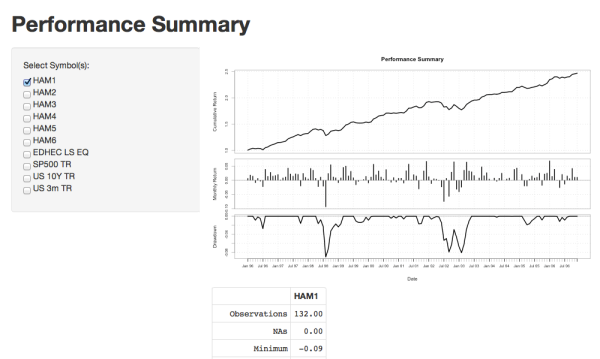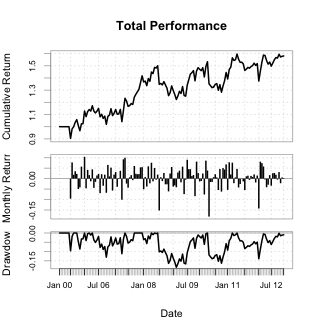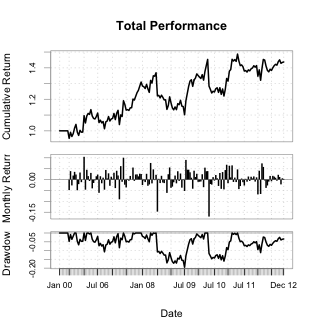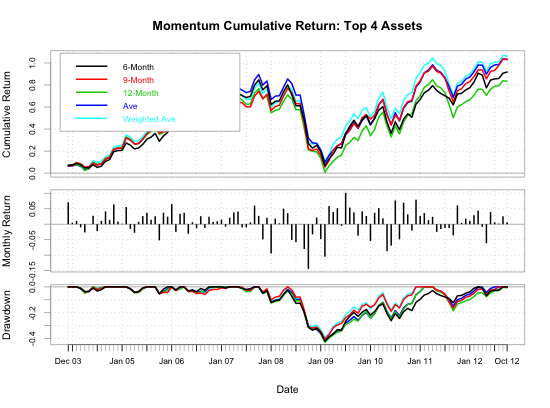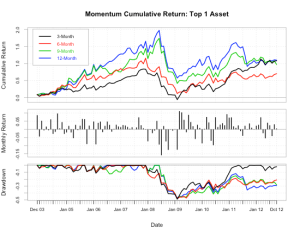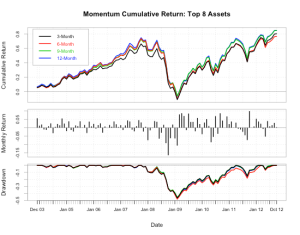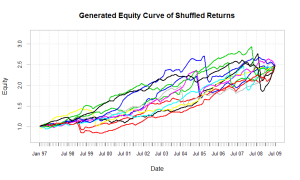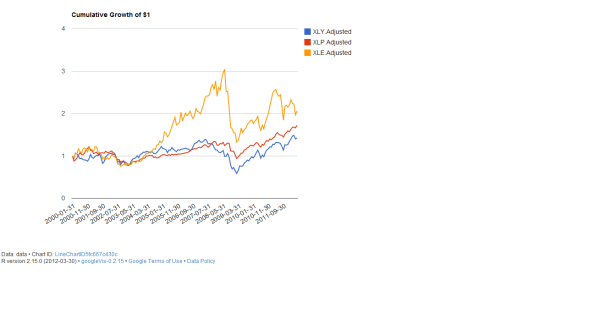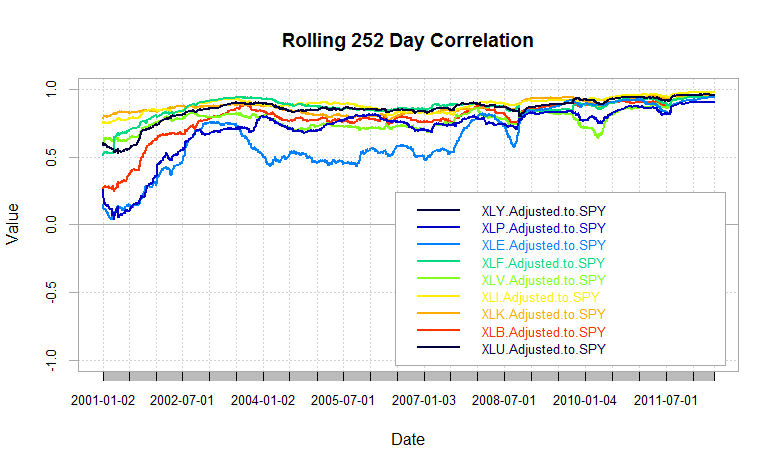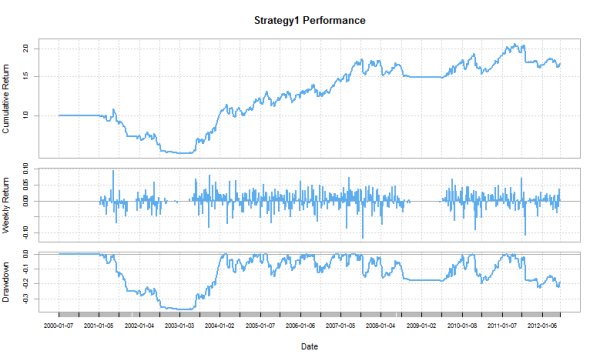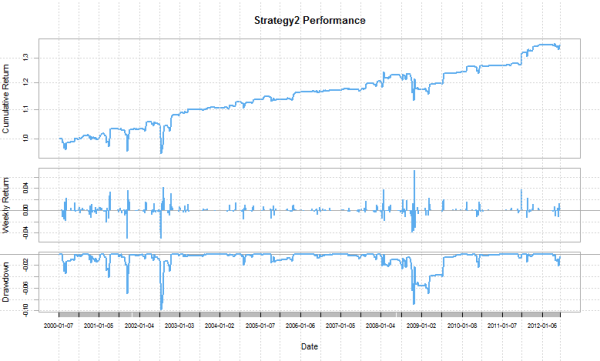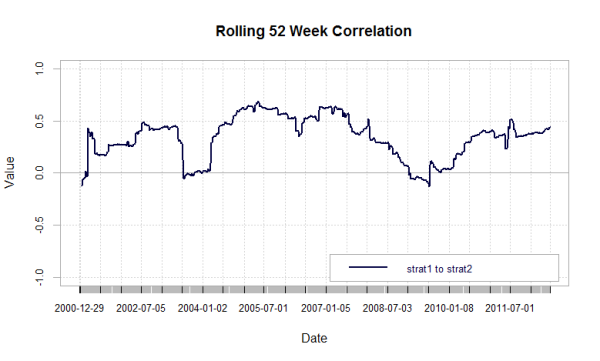# rank_test2.R
# script to run a simple backtest comparing different ranking methods
# for a momentum based trading system
# remove objects from workspace
rm(list = ls())
# load required packages
library(FinancialInstrument)
library(TTR)
library(PerformanceAnalytics)
MonthlyAd <- function(x){
# Converts daily data to monthly and returns only the monthly close
# Note: only used with Yahoo Finance data so far
# Thanks to Joshua Ulrich for the Monthly Ad function
#
# args:
# x = daily price data from Yahoo Finance
#
# Returns:
# xts object with the monthly adjusted close prices
sym <- sub("\\..*$", "", names(x)[1])
Ad(to.monthly(x, indexAt = 'lastof', drop.time = TRUE, name = sym))
}
CAGR <- function(x, m){
# Function to compute the CAGR given simple returns
#
# args:
# x = xts of simple returns
# m = periods per year (i.e. monthly = 12, daily = 252)
#
# Returns the Compound Annual Growth Rate
x <- na.omit(x)
cagr <- apply(x, 2, function(x, m) prod(1 + x)^(1 / (length(x) / m)) - 1, m = m)
return(cagr)
}
RankRB <- function(x){
# Computes the rank of an xts object of ranking factors
# ranking factors are the factors that are ranked (i.e. asset returns)
#
# args:
# x = xts object of ranking factors
#
# Returns:
# Returns an xts object with ranks
# (e.g. for ranking asset returns, the asset with the greatest return
# receives a rank of 1)
r <- as.xts(t(apply(-x, 1, rank, na.last = "keep")))
return(r)
}
SimpleMomentumTest <- function(xts.ret, xts.rank, n = 1, ret.fill.na = 3){
# returns a list containing a matrix of individual asset returns
# and the comnbined returns
# args:
# xts.ret = xts of one period returns
# xts.rank = xts of ranks
# n = number of top ranked assets to trade
# ret.fill.na = number of return periods to fill with NA
#
# Returns:
# returns an xts object of simple returns
# trade the top n asset(s)
# if the rank of last period is less than or equal to n,
# then I would experience the return for this month.
# lag the rank object by one period to avoid look ahead bias
lag.rank <- lag(xts.rank, k = 1, na.pad = TRUE)
n2 <- nrow(lag.rank[is.na(lag.rank[,1]) == TRUE])
z <- max(n2, ret.fill.na)
# for trading the top ranked asset, replace all ranks above n
# with NA to set up for element wise multiplication to get
# the realized returns
lag.rank <- as.matrix(lag.rank)
lag.rank[lag.rank > n] <- NA
# set the element to 1 for assets ranked <= to rank
lag.rank[lag.rank <= n] <- 1
# element wise multiplication of the
# 1 period return matrix and lagged rank matrix
mat.ret <- as.matrix(xts.ret) * lag.rank
# average the rows of the mat.ret to get the
# return for that period
vec.ret <- rowMeans(mat.ret, na.rm = TRUE)
vec.ret[1:z] <- NA
# convert to an xts object
vec.ret <- xts(x = vec.ret, order.by = index(xts.ret))
f <- list(mat = mat.ret, ret = vec.ret, rank = lag.rank)
return(f)
}
WeightAve3ROC <- function(x, n = c(1,3,6), weights = c(1/3, 1/3, 1/3)){
# Computes the weighted average rate of change based on a vector of periods
# and a vector of weights
#
# args:
# x = xts object of simple returns
# n = vector of periods to use n = (period1, period2, period3)
# weights = a vector of weights for computing the weighted average
#
# Returns:
# xts object of weighted average asset rate of change
if((sum(weights) != 1) || (length(n) != 3) || (length(weights) != 3)){
stop("The sum of the weights must equal 1 and the length of n and weights must be 3")
} else{
roc1 <- ROC(x, n = n[1], type = "discrete")
roc2 <- ROC(x, n = n[2], type = "discrete")
roc3 <- ROC(x, n = n[3], type = "discrete")
wave <- (roc1 * weights[1] + roc2 * weights[2] + roc3 * weights[3]) / sum(weights)
return(wave)
}
}
currency("USD")
symbols <- c("XLY", "XLP", "XLE", "XLF", "XLV", "XLI", "XLK", "XLB", "XLU", "EFA")
stock(symbols, currency = "USD", multiplier = 1)
# create new environment to store symbols
symEnv <- new.env()
# getSymbols and assign the symbols to the symEnv environment
getSymbols(symbols, from = '2002-09-01', to = '2012-10-20', env = symEnv)
# xts object of the monthly adjusted close prices
symbols.close <- do.call(merge, eapply(symEnv, MonthlyAd))
# monthly returns
monthly.returns <- ROC(x = symbols.close, n = 1, type = "discrete", na.pad = TRUE)
#############################################################################
# rate of change and rank based on a single period for 6, 9, and 12 months
#############################################################################
roc.six <- ROC(x = symbols.close , n = 6, type = "discrete")
rank.six <- RankRB(roc.six)
roc.nine <- ROC(x = symbols.close , n = 9, type = "discrete")
rank.nine <- RankRB(roc.nine)
roc.twelve <- ROC(x = symbols.close , n = 12, type = "discrete")
rank.twelve <- RankRB(roc.twelve)
#############################################################################
# rate of change and rank based on averaging 6, 9, and 12 month returns
#############################################################################
roc.ave <- WeightAve3ROC(x = symbols.close, n = c(6, 9, 12),
weights = c(1/3, 1/3, 1/3))
rank.ave <- RankRB(roc.ave)
roc.weight.ave <- WeightAve3ROC(x = symbols.close, n = c(6, 9, 12),
weights = c(1/6, 2/3, 1/6))
rank.weight.ave <- RankRB(roc.weight.ave)
#############################################################################
# run the backtest
#############################################################################
num.assets <- 4
# simple momentum test based on 6 month ROC to rank
case1 <- SimpleMomentumTest(xts.ret = monthly.returns, xts.rank = rank.six,
n = num.assets, ret.fill.na = 15)
# simple momentum test based on 9 month ROC to rank
case2 <- SimpleMomentumTest(xts.ret = monthly.returns, xts.rank = rank.nine,
n = num.assets, ret.fill.na = 15)
# simple momentum test based on 12 month ROC to rank
case3 <- SimpleMomentumTest(xts.ret = monthly.returns, xts.rank = rank.twelve,
n = num.assets, ret.fill.na = 15)
# simple momentum test based on average of 6, 9, and 12 month ROC to rank
case4 <- SimpleMomentumTest(xts.ret = monthly.returns, xts.rank = rank.ave,
n = num.assets, ret.fill.na = 15)
# simple momentum test based on weighted average of 6, 9, and 12 month ROC to rank
case5 <- SimpleMomentumTest(xts.ret = monthly.returns, xts.rank = rank.weight.ave,
n = num.assets, ret.fill.na = 15)
returns <- cbind(case1$ret, case2$ret, case3$ret, case4$ret, case5$ret)
colnames(returns) <- c("6-Month", "9-Month", "12-Month", "Ave", "Weighted Ave")
charts.PerformanceSummary(R = returns, Rf = 0, geometric = TRUE,
main = "Momentum Cumulative Return: Top 4 Assets")
table.Stats(returns)
cagr <- CAGR(returns, m = 12)
max.dd <- maxDrawdown(returns)
print(cagr)
print(max.dd)
print("End")
